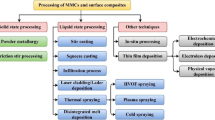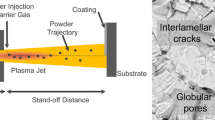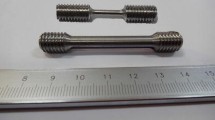Abstract
The morphology and composition of an oxide layer on the surface of iron chipping cuts obtained using metal-working under conditions of intense plastic shear deformation and subsequent thermal oxidation have been investigated by scanning electron microscopy with an X-ray probe, Raman spectroscopy, and thermogravimetry. It is shown that agglomerations of metal–oxide nanoparticles and nanostructures (whiskers, nanotips, and nanoleaves), which are promising for production of new composites with ultra-fine-grained metal–oxide filler, are formed with a high rate on the surface of metal chippings during annealing in air at 800°C. The economic and ecological benefits due to recycling of metalworking wastes for producing new metal–oxide nanomaterials and related composites appear to be significant.







Similar content being viewed by others
Notes
The main structural feature of nanocrystalline and fine-grained materials obtained by deformation methods is the presence of nonequilibrium grain boundaries, which are sources of high elastic stress. Another stress source is triple junctions of grains. According to different estimates, the grain boundary width in nanomaterials varies from 2 to 10 nm. Nonequilibrium grain boundaries contain many dislocations, and there are uncompensated disclinations in grain junctions. The dislocation density inside grains is much lower than that at the boundaries. The dislocations and disclinations form long-range stress fields concentrating near the grain boundaries and triple junctions and cause the excess energy of the grain boundaries. Annealing of the strained material leads to stress relaxation and approaching the equilibrium state of the grain boundaries [10].
A similar effect of lateral growth of oxide whiskers (needles) of iron nanoparticles was previously observed during the formation of urchinlike nanostructures upon thermal oxidation and depassivation of iron particles [37].
Indeed, one of the necessary elementary events during metal oxidation is exit of a metal atom (ion) from the metal to a free vacancy site in the oxide matrix. Obviously, in this case, a vacancy in the metal matrix remains in the metal in the place of the metal atom. It is known that these vacancies migrate to the metal bulk during the metal oxidation and are accumulated and condensed in voids at the metal–oxide interface, which eventually leads to exfoliation of the oxide film from the metal [43]. Diffusion of metal atoms through these voids from the metal to the oxide phase is impossible, which limits significantly the average metal-oxidation rate.
The specific volume of the material changes during oxidation and transformation of iron in the oxide layer, which leads to an increase in the internal stress and imperfection in the oxide layer. For example, the interface reaction Fe2O3 → Fe3O4 [51] for the phase transition at the metal–Fe2O3 interface induces high interfacial stress due to the difference between the hematite and magnetite molar volumes. The interfacial stress is relaxed by acceleration of the grain-boundary diffusion of the metal outward (atomic flux due to stress-induced migration) [39, 40], which is likely to lead to accelerated growth of nanoleaves and nanowires on the upper faces of Fe2O3 grains. As a result, hematite whiskers “pressed out” from the oxide bulk by internal stress begin to grow from the less strained vertices of grains of the hematite phase formed at the interface with a gas. The heavily strained and defective magnetite sublayer provides high rates of ion transport and diffusion of the metal to the base of the hematite whisker. A possible mechanism for this is short-circuited diffusion. Obviously, this factor causes the high growth rate of hematite nanowhiskers [37].
REFERENCES
Gleiter, H., Nanostruct. Mater., 1992, vol. 1, no. 1, p. 1.
1-Dimensional Metal Oxide Nanostructures: Growth, Properties, and Devices, Advances in Materials Science and Engineering, Lockman, Z., Ed., Boca Raton: CRC Press, 2019.
Suzdalev, I.P., Nanotekhnologiya: fizikokhimiya nanoklasterov, nanostruktur i nanomaterialov (Nanotechnology: Physical Chemistry of Nanoclusters, Nanostructures, and Nanomaterials), Moscow: KomKniga, 2006.
Synthesis, Properties, and Applications of Oxide Nanomaterials, Rodríguez, J.A. and Fernández-García, M., Eds., Hoboken, NJ: Wiley, 2007.
Takagi, R., J. Phys. Soc. Jpn., 1957, vol. 12, p. 1212.
Laukonis, J.V. and Coleman, R.V., J. Appl. Phys., 1959, vol. 30, p. 1364.
Srivastava, H., Tiwari, P., Srivastava, A.K., and Nandedkar, R.V., J. Appl. Phys., 2007, vol. 102, p. 054303.
Chioncel, M.F., Diaz-Guerra, C., and Piqueras, J., J. Appl. Phys., 2008, vol. 104, p. 124311.
Kolmakov, A.G., Barinov, S.M., and Alymov, M.I., Osnovy tekhnologii i primenenie nanomaterialov (Fundamentals for Technologies and Application of Nanomaterials), Moscow: FIZMATLIT, 2012.
Gusev, I.A., Usp. Fiz. Nauk, 1998, vol. 68, no. 1, pp. 55–83.
Karbasi, M., Tavangarian, F., Vardak, S., and Saidi, A., Prot. Met. Phys. Chem. Surf., 2013, vol. 49, no. 5, p. 548.
Cvelbar, U., Chen, Z., Sunkara, M.K., and Mozetic, M., Small, 2008, vol. 4, no. 10, pp. 1610–1614.
Kennedy, J.H. and Anderman, M., J. Electrochem. Soc., 1983, vol. 130, p. 848.
Chauhan, P., Annapoorni, S., and Trikha, S., Thin Solid Films, 1999, vol. 346, p. 266.
Ohmori, T., Takahashi, H., Mametsuka, H., and Suzuki, E., Phys. Chem. Chem. Phys., 2000, vol. 2, p. 3519.
Weiss, W., Zscherpel, D., and Schlogl, R., Catal. Lett., 1998, vol. 52, p. 215.
Lu Yuan, Yiqian Wang, Rongsheng Cai, Qike Jiang, Jianbo Wang, Boquan Li, Anju Sharma, and Guangwen Zhou, Mater. Sci. Eng., B., 2012, vol. 177, pp. 327–336.
Wen Xiaogang, Wang Suhua, Ding Yong, et al., J. Phys. Chem. B, 2005, vol. 109, p. 215.
Yingying Xu, Guanxiang Yun, Zhao Dong, et al., Nanoscale, 2012, vol. 4, p. 257.
Kotenev, V.A., Zhorin, V.A., Kiselev, M.R., Vysotskii, V.V., Averin, A.A., Roldugin, V.I., and Tsivadze, A.Yu., Prot. Met. Phys. Chem. Surf., 2014, vol. 50, no. 6, pp. 792–796.
Raynaud, G. and Rapp, R., Oxid. Met., 1984, vol. 21, p. 89.
Fu, Y., Chen, J., and Zhang, J., Chem. Phys. Lett., 2001, vol. 350, p. 491.
Tu, K.N. and Li, J.C.M., Mater. Sci. Eng., A, 2005, vol. 409, p. 131.
Koch, C.C., Ovid’ko, I.A., Sudipta, S.S., and Veprek, S., Structural Nanocrystalline Materials: Fundamentals and Applications, Cambridge: Cambridge Univ. Press, 2007.
Valiev, R.Z. and Aleksandrov, I.V., Nanostrukturnye materialy, poluchennye intensivnoi plasticheskoi deformatsiei (Nanostructured Materials Generated by means of Intensive Plastic Deformation), Moscow: Logos, 2000.
Jaspers, S.P.F.C. and Dautzenberg, J.H., J. Mater. Process. Technol., 2002, vol. 121, pp. 123–135.
Brown, T.L., Swaminathan, S., Chandrasekar, S., Compton, W.D., King, A.H., and Trumble, K.P., J. Mater. Res., 2002, vol. 17, pp. 2484–2488.
Deng, W.J., Xia, W., Li, C., and Tang, Y., J. Mater. Process. Technol., 2009, vol. 209, pp. 4521–4526.
Deng, W.J., Xia, W., Li, C., and Tang, Y., Mater. Manuf. Processes, 2010, vol. 25, pp. 355–359.
Gardiner, D.J., Littleton, C.J., Thomas, K.M., and Stratford, K.N., Oxid. Met., 1987, vol. 27, p. 57.
Tjong, S.C., Mater. Res. Bull., 1983, vol. 18, p. 157.
Singh Raman, R.K., Gleeson, B., and Young, D.J., Mater. Sci. Technol., 1998, vol. 14, p. 373.
Thibeau, R.J., Brown, C.W., and Heidersbach, R.H., Appl. Spectrosc., 1978, vol. 32, p. 532.
Nasibulin, A.G., Rackauskas, S., Jiang, H., Tian, Y., Mudimela, P.R., Shandakov, S.D., Nasibulina, L.I., Jani Sainio, J., and Kauppinen, E.I., Nano Res., 2009, vol. 2, pp. 373–379.
de Faria, D.L.A., Silva, V., and de Oliveira, M.T., J. Raman Spectrosc., 1997, vol. 28, pp. 873–878.
Voss, D.A., Butler, E.P., and Mitchell, T.E., Metall. Trans. A, 1982, vol. 13, pp. 929–935.
Kotenev, V.A., Kiselev, M.R., Vysotskii, V.V., Averin, A.A., and Tsivadze, A.Yu., Prot. Met. Phys. Chem. Surf., 2016, vol. 52, no. 5, pp. 825–831.
Tohmyoh, H. and Watanabe, A., J. Phys. Soc. Jpn., 2013, vol. 82, p. 044804.
Herring, C., J. Appl. Phys., 1950, vol. 21, p. 437.
Korhonen, M.A., Borgesen, P., Tu, K.N., and Li, C.-Y., J. Appl. Phys., 1993, vol. 73, p. 3790.
L’Oxydation des Metaux, Bénard, J., Ed., Paris: Gauthier-Villars, 1962, vol. 2.
Svedung, I., Hammar, B., and Vannerberg, N., Oxid. Met., 1973, vol. 6, no. 1, pp. 21–44.
Dunnington, B., Beck, F., and Fontana, M., Corrosion, 1952, vol. 8, p. 2.
Wei Jiangi, Jiaping Qiu, Shaojun Yuan, Ying Wan, Jiemin Zhong, and Bin Liang, Prot. Met. Phys. Chem. Surf., 2015, vol. 51, p. 435.
Rudnev, V.S., Wybornov, S., Lukiyanchuk, I.V., and Chernykh, I.V., Prot. Met. Phys. Chem. Surf., 2014, vol. 50, no. 2, pp. 191–194.
Soliman, H. and Hamdy Abdel Salam, Prot. Met. Phys. Chem. Surf., 2015, vol. 51, p. 620.
Vayssieres, L. and Manthiram, A., One-Dimensional Metal Oxide Nanostructures, in Encyclopedia of Nanoscience and Nanotechnology, Nalwa, H.S., Ed., Stevenson Ranch, CA: American Scientific Publ., 2008, vol. 8, p. 147.
Lu, J., Chang, P., and Fan, Z., Mater. Sci. Eng., R, 2006, vol. 52, p. 49.
Comini, E., Baratto, C., Faglia, G., et al., Prog. Mater. Sci., 2009, vol. 54, p. 1.
Kotenev, V.A. , Kiselev, M.R. , Zolotarevskii, V. I., and Tsivadze, A.Yu., Prot. Met. Phys. Chem. Surf., 2014, vol. 50, no. 4, pp. 488–492.
Kotenev, V.A., Prot. Met. Phys. Chem. Surf., 2018, vol. 54, no. 5, p. 969–975.
Funding
This study was performed within the framework of a state order on the subject “Physical Chemistry of Functional Materials Based on Architectural Ensembles of Metal–Oxide Nanostructures, Multilayer Nanoparticles, and Film Nanocomposites,” registration number of research, development, and technological work AAAA-A19-119031490082-6.
Author information
Authors and Affiliations
Corresponding author
Additional information
Translated by A. Sin’kov
Rights and permissions
About this article
Cite this article
Kotenev, V.A., Vysotskii, V.V., Kiselev, M.R. et al. Formation of Metal–Oxide Nanostructures during Oxidation of Cuts of Plastically Deformed Iron. Prot Met Phys Chem Surf 56, 485–492 (2020). https://doi.org/10.1134/S207020512003020X
Received:
Revised:
Accepted:
Published:
Issue Date:
DOI: https://doi.org/10.1134/S207020512003020X




